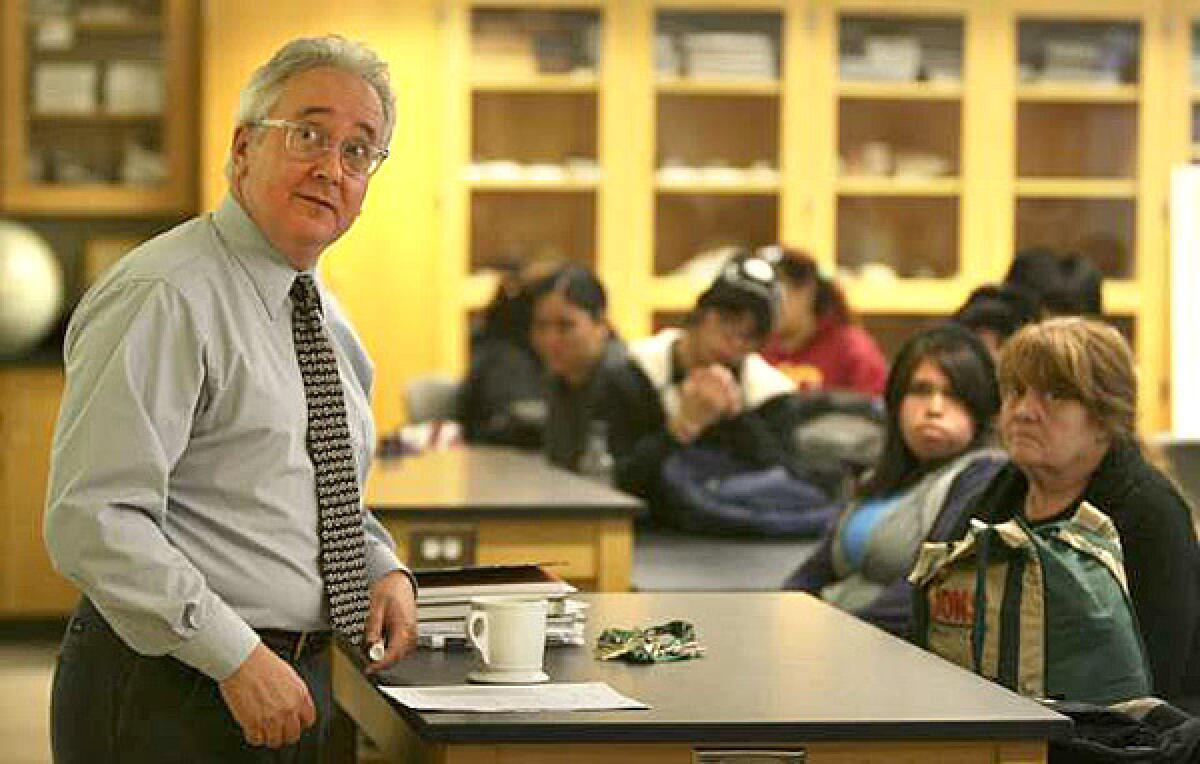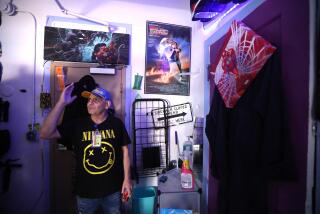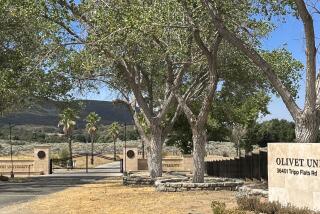A new complex riddled with ills that are costly to cure

The opening of a new health and science center at Los Angeles Valley College should have been cause for celebration. The complex included the first new classroom building on the campus in more than three decades. There were chemistry and biology labs, a greenhouse, an aviary, even mock hospital rooms for nurse training.
But when students and professors poured through the doors, excitement quickly turned to dismay.
Billions to Spend: Complete Coverage
Ceiling panels and floor tiles were askew. Crooked cabinet doors would not shut.
Hot water ran through cold water pipes, cold water through hot. Hot, dirty water flowed at emergency eyewash stations, making them useless. Spigots at some sinks were misaligned, pointing water straight onto lab counters.
Wild temperature swings left students roasting or freezing. A deep chill killed lizards in a biology lab. An imbalance in air pressure created a wind-tunnel effect, and it took a herculean effort to open or close classroom doors.
The problems at the Allied Health and Science Center went well beyond comfort or convenience. Exit signs and fire extinguishers were missing. Hanging pipes and light fixtures were not securely attached to ceilings.
Chemistry professor Elizabeth Friedman was appalled at the builders’ work.
“I wouldn’t let them build an outhouse for me,” she said.
The Los Angeles Community College District, which paid a contractor more than $48 million to build the science center, had to pay other firms at least $3.5 million more to fix and complete it. The district and the original contractor, FTR International of Irvine, are embroiled in a court fight, with each seeking to recover money from the other.
The project offers a vivid illustration of the oversight and quality control problems that have plagued the district’s $5.7-billion voter-approved bond program to rebuild its nine campuses.
Nizar Katbi, founder and president of FTR, defended his company’s performance. In an interview, he said FTR met its obligations even though architectural plans were often vague and energy-conservation features posed difficult challenges.
“Every problem brought to our attention has been addressed and taken care of,” Katbi said.
Dozens of interviews and a review of hundreds of internal e-mails and other documents tell a different story. They show that inspectors, architects and project managers began finding serious construction defects early on and grew increasingly frustrated as deadlines came and went and the complex ultimately opened with many of the problems uncorrected.
Those supervising the project on the ground pleaded with higher-ups to deal firmly with FTR. Yet the top two officials overseeing the construction program did not share their urgency.
They publicly praised the contractor’s work and repeatedly approved payments to FTR over the objections of Valley College officials and construction supervisors, who wanted the money held back until problems were corrected. The district had the right to withhold nearly $5 million but released almost $4 million, forfeiting a key source of leverage.
The conciliatory approach was charted by Larry Eisenberg, the district official in charge of the building program, and James D. Sohn, then a vice president of URS Corp. of San Francisco, the college district’s construction manager.
When Katbi became embroiled in a dispute with an inspector who had documented numerous flaws, Eisenberg urged subordinates to consider transferring the inspector, records show. Later, Eisenberg argued forcefully against suing FTR.
Two years after construction began, and after inspectors and architects had cited the company for hundreds of instances of substandard work, Sohn sent Katbi a letter thanking FTR for a “job well done.” FTR posted the letter on its website as a client testimonial.
Sohn declined to be interviewed.
Eisenberg said FTR was “a good company” that had struggled with a difficult project, and he defended his attempts at accommodation.
“My feeling was that there was an opportunity to work in a positive way with FTR to resolve the issues,” he said.
Eisenberg admitted that in the end, “it didn’t work.”
Months after the complex opened, the district awarded FTR an even bigger contract at West Los Angeles College, followed by more projects at Pierce and Mission colleges — a total of $113 million in new work.
In December 2008, the district celebrated a California Construction magazine award recognizing FTR and the Allied center at Valley College.
“I was speechless,” said Don Gauthier, an associate geography professor who teaches in the complex. “These are the people who have just caused us so much agony.”
A test for officials
The Allied project — a pair of attached buildings, one with classrooms, the other with faculty offices — was supposed to be a huge step forward for a campus built in the era of black-and-white TV.
Departments scattered around the Valley Glen campus would be gathered in one place to offer nursing, science and other classes central to the college’s mission of training students for jobs.
As one of the first large projects in the district’s building program, the 100,000-square-foot complex would test the ability of Eisenberg and Sohn to choreograph dozens of projects on campuses spread across the Los Angeles area.
FTR won the job after submitting the lowest of four bids — $46 million.
Katbi, a Syrian immigrant, founded the company in 1984 after earning a master’s degree in engineering at the University of Iowa. Since then, FTR has built school buildings, police stations and athletic facilities across Southern California.
Like other contractors working on the campus construction program, the firm has cultivated close ties to college district leaders. It contributed $60,000 to a campaign to encourage voters to expand the program in 2008 and thousands more to help reelect three members of the district’s Board of Trustees.
Construction of the Allied buildings began in April 2006 and was supposed to be finished two years later. Subcontractors performed much of the work, but as the prime contractor, FTR was responsible for all of it.
There were problems from the start. Sixteen concrete piles were sunk in the wrong locations, inspectors found. One was more than four feet from the spot designated in blueprints. To ensure the building’s structural integrity, engineers insisted on extra concrete and on steel reinforcement of four piles.
As work progressed, Robert Payinda, a district construction inspector, uncovered other flaws. Beams were installed in the wrong locations. Columns were crooked. Staircases were not firmly anchored to the ground. Fireproofing was sloppy. Bolts were too close together or too far apart.
Ricardo Hernandez, an engineer who monitored the project, called Payinda “a lifesaver.”
“Whenever he saw things awry,” Hernandez said, “he always put his foot in front of it and said, ‘Hey, this has got to stop.’ ”
But Payinda’s frequent citations angered Katbi, who regarded him as a nitpicker. In a letter to one of the district’s top construction supervisors, Katbi accused the inspector of “sabotaging the job and causing unnecessary cost and delays for the college.”
In a February 2007 e-mail, an Eisenberg advisor listed ways to defuse the situation. “Option No. 2” was moving Payinda to a different project.
Eisenberg replied, “Like your #2,” and copied chief of inspectors Frank Alaniz, asking: “What do you think?”
Alaniz countered that Payinda was “doing exactly what we’re paying him to do on our behalf.”
Payinda remained on the job. He called the contractor’s complaints “bullying tactics” and later sued FTR for slander. The case is pending.
Relations deteriorate
As FTR was forced to fix mistakes, delays mounted. In April 2007, URS project manager Robert Dieken told the contractor that the defects were “extremely troublesome and an indication that your quality control process is not functioning properly.” By July, the project was more than five months behind schedule.
Relations between the contractor and URS’ on-site supervisors deteriorated. They wanted FTR to work faster and repair its mistakes. FTR said that the delays were not its fault and that it needed money to keep the project on course.
Early on, FTR had threatened to stop work unless the district sped up payments. Now, it agreed to pick up the pace, but only if the district increased its contract by $2.3 million to deal with unforeseen site conditions, including asbestos contamination.
Those overseeing the construction — architects, engineers, inspectors and Valley College staff members — wanted to take a hard line. Katbi took his case to Eisenberg and Sohn, who favored a gentler approach.
The district had paid a law firm nearly $18,000 to document FTR’s alleged deficiencies, but Eisenberg joined Katbi in arguing that a lawsuit would be a waste of money.
“We understand that LACCD has an army of lawyers as you have indicated in our meeting,” Katbi told Sohn in an August 2007 letter. “However, Larry and I have committed that neither one of us is interested in the lawyers having any role on this project.”
FTR started trading offers with Eisenberg and Sohn for a settlement to get the project on track.
In November 2007, the two sides agreed to a $3-million increase in FTR’s contract. The agreement set construction milestones that FTR had to reach by specified dates. Eisenberg and Sohn sold it to reluctant Valley College leaders as the best way to get the buildings finished on time.
FTR agreed to complete construction by May 30, 2008.
Inspector’s ‘harassment’
Days after the agreement, the company demanded a new concession: early release of several million dollars that the district had the right to withhold until the project was done.
Typically, public agencies retain 10% of all payments until a job is at least halfway to completion. At that point, they often reduce the “retention” and withhold, say, 5%. But normally, agencies release retention money only if a job is going well.
This one was not.
Where the design called for three layers of drywall for fire safety, workers had installed two. Where holes were punched in drywall for pipes, Payinda wrote, the openings were caulked improperly, which “greatly compromises the fire and life safety of the building and occupants.”
“The district is not only NOT getting the building they paid for but they are paying more to get less,” Payinda wrote in a memo to architect Michael Johnson, two months after the deal to increase FTR’s contract.
Katbi asked project managers to stop the inspector’s “harassment.” He also complained that the architects who designed the complex were taking too long to respond to requests for design clarifications. The latest delays, Katbi wrote, were not FTR’s fault, and the contractor needed money.
“As per our discussion, the more cash in our hand the faster the job will be built,” Katbi told Sohn in a February 2008 letter that he also sent to Eisenberg.
Tom Lopez, Valley’s facilities director, asked why the college should “give up any leverage.”
FTR had been uncooperative and confrontational, he wrote. He doubted it would finish the job on time.
But on April 1, 2008, Eisenberg approved the early release of almost $925,000. Six weeks later, although it was clear by then that FTR would miss the May 30 deadline, the district released $930,000 more.
The idea, Eisenberg said in an interview, was “to encourage different behavior and hopefully make FTR do a better job.”
By then, Payinda had issued 368 citations. Concrete was cracked. Roof drains did not work. Metal studs that were supposed to be solid were hollow.
While the inspector and architects cranked out reports demanding repairs, Sohn sent Katbi the admiring letter that FTR posted on its website.
“We have had hundreds of contractors work with us over the years, and your firm stands out as among the best,” Sohn wrote.
The project fell further behind. Katbi blamed the latest delays on the district’s change in its choice of carpeting and its slow pace in resolving troubles with water and gas lines, among other things. “The settlement agreement does not require FTR to perform miracles,” he wrote.
As the fall 2008 semester drew closer, a project manager suggested halting the release of retention money unless the job was done by the end of July.
“I completely disagree,” Sohn responded. “By not paying FTR you are giving him no resources to finish and put his enthusiastic support at risk.”
“Right on,” Eisenberg wrote after getting a copy of Sohn’s e-mail.
Payinda soon issued his final citation — his 422nd — for deviations from the design. In every faculty office, the inspector found, metal heating panels hanging from the ceilings were vulnerable to collapse, with little holding them in place.
Unless the problem was fixed, he wrote, someone might “get injured seriously should a seismic event occur.”
The following week, just as classes were starting, an architect reported that in room after room, workers had installed ceiling tiles prematurely. This made it impossible to verify that the heating panels had been securely anchored.
‘Frustration and disgust’
Disappointment was profound when the complex opened in August 2008. The twin buildings were unfinished, and faculty found the science labs unusable.
In an e-mail, Lopez, the campus facilities chief, described the college community’s reaction as “dissatisfaction, frustration, and disgust.”
Fire sprinklers were improperly installed, project managers found. A district consultant reported that an FTR subcontractor had falsified test results on the heating system, which was not working.
“Your firm is not close to finishing the project,” construction manager Jim Rogers of URS told Katbi in response to the contractor’s latest request for money.
At the end of December, the district released an additional $2 million in retention money, leaving less than $800,000 as leverage. A URS employee scrawled “Please RUSH” on the financial paperwork.
A month later, Eisenberg gushed about the project in a “Hot Project Status Report” to the Board of Trustees. “The Allied Health and Science Building at Valley College continues to win awards,” he wrote, referring to recognition from a construction trade group.
After hearing repeated “horror stories,” Marshall Drummond, then chancellor of the college system, toured the complex in February 2009.
He was stunned by room temperatures that veered from 60 to 92 degrees.
“I pretty much insist that we get on people and fix this mess,” he told Eisenberg in an e-mail.
Eisenberg dispatched a construction manager, Victor Sanvido, to survey the project.
“What you have here,” Sanvido reported back, “is an emergency situation — the building needs much work done to it and it needs to be done soon to prevent further deterioration.”
In May 2009, the district hired a new contractor, Pankow Special Projects, to fix the problems that faculty and students had now been living with for nine months.
Pankow would reroute the plumbing. It would add drywall for fire safety and brace the ceiling fixtures. It would repair cabinets and doors, balance the air pressure and fix the heating and air conditioning systems.
When Pankow’s contract went before the Board of Trustees, Eisenberg buried a description of the work in a $4.4-million catch-all project labeled “multi-campus retro-commissioning upgrades.”
In an interview, Eisenberg at first insisted that Pankow was hired to do newly assigned work on the buildings. He later acknowledged that a third of Pankow’s contract involved fixing defects and completing work left unfinished by FTR.
“There’s no doubt that the building had numerous issues when it was stated as complete, and those issues needed to be fixed,” Eisenberg said.
When a contractor does “minimally acceptable work,” he said, it “often makes sense to … bring in someone else to complete the job and correct the errors that are there rather than pay the lawyers.”
Contractor sues district
FTR moved on to a bigger job: a $74-million contract to build a technology center and theater complex at West Los Angeles College in Culver City.
Under a new state law that lets public agencies merge design and construction, the district was not required to pick the lowest bidder, as it had been on the Allied complex. The law allows agencies to consider design aesthetics, a bidder’s track record and other factors, along with price.
The district chose FTR over 10 other bidders for the project, which has since been scaled back to just the technology center. Eisenberg called FTR’s proposal “outstanding.”
Last spring, FTR sued the district over the Valley College project, saying it was owed more than $1 million for its work.
In response, the district accused FTR of performing “defective work” and refusing to fix it. It demanded $1.5 million to cover the cost of Pankow’s repairs. The case is pending.
Nonetheless, the Board of Trustees went on to award FTR a $9-million design-construction job at Pierce College in April and a similar $29-million project at Mission College in July.
In an interview, Eisenberg said he had no hesitation about working with FTR again. He described Allied as a “snake-bit” project.
“FTR,” he said, “is a good company.”
Times staff writer Doug Smith contributed to this report.
More to Read
Sign up for Essential California
The most important California stories and recommendations in your inbox every morning.
You may occasionally receive promotional content from the Los Angeles Times.











